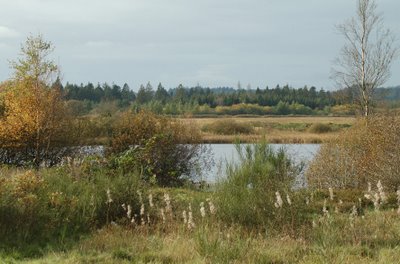 |
| The Bride's Lake, Mid Jutland |
Once upon a time the country was filled with lakes, large and small, tiny, even tiny as ponds. There are still many lakes, but lots and lots have disappeared. Some have grown into moors, others sanded up in the run-up, and valuable land was drained and reclaimed for farming.
 |
| Mossøe, early morning |
It is not strange that people from the legendary time experienced many weird things by the lakes. Many lakes were sacred, and the power of a sacred lake was considered to be very strong. Our forefathers sacrificed to the mighty gods of the lake. All the precious booty they brought back from a war, pretty ships, thousands of swords, spears and other weapons of the finest quality. Later a lake like that turned into a moor, and today we have found precious, sacrificed treasures in places, where we were digging for peat.
A sacred lake was even more sacred and awesome, when the ancient people knew of the sacrificed treasures on the bottom. It was not a place they liked to approach. The yearly sacrifices included also the spring offering When the fertility god Frøj drove his wagon across the newly sowed fields to bless them with fertility and growth, the wagon with oxes and slaves were lowered into the lake. Milleniums later a wagon was found in a Zealand-moor, which was once a lake, the Dejbjergvogn. Lakes and moors with sacrifices are known from several places. (Nydam Mose, Illerup Ådal).
 |
| Small lake and moor in Rold Skov |
Some lakes are named Brudesø (Bride's lake). A small lake near the town Ry in Mid Jutland is called Bride's Lake. I often come to this place because it's on the way to some special places in the middle of Jutland. The lake lies by a small side road of the motor road, a listed lake with listed surroundings of field and heath. The lake has a legend about a drowned bride, and this might be one of those legends that origins from a long forgotten time, where it was a sacred lake, receiving sacrifices to the gods. What does it hide deep down? No one knows, and there is no time or money enough to search in every mysterious lake with an enigmatic name.
There is a path around the lake today, but in the legend there was a path through a field, where the Bride's Lake now lies. A guy and a girl were sweethearts; he was poor and she was rich. They were not allowed to marry, but she promised him to be faithful. If she wasn't, she would sink into the earth on the day she got married to someone else. Years went on and a rich suitor came along. She forgot her promise and married him. When they drove from church, a terrible storm arose, and the bride's wagon was suddenly shrouded in fog. No one could see the young bride, but a heartrending scream was heard. When the fog finally drifted away, the wagon and the bride had disappeared, and at the place of the path was now a lake. Only her hymn book and her bridal wreath were found.
Another version tells that the wagon lost its way in a snow storm and the bride and groom drowned. Afterwards were their apparations seen at the place - and a capsizing boat was seen with the bride in the middle of the lake.
 |
| Huldremose (Moor of the Water Nymph), Djursland |
Many lakes hold legends about drowned people. The story about a drowned bride and a wagon is often told. It might origin from an obscure story tradition about ancient sacrifice to the gods, where the god, his bride and their wagon were sacrificed to the lake after their tour in the fields. After centuries people were no longer familiar with the background-story, instead they had invented a reasonable explanation that it had something to do with unrequited love or broken promise.
| Brudesø (Bride's Lake) Mid Jutland |
Today the Bride's lake still lies there, keeping its
secrets. Imagine what treasures lie in that bottomless depth?
Anything is possible!
Source:
Danske søer og vandløb fra sagn og tro, Mads Lidegaard, Nyt Nordisk Forlag, Arnold Busck, 1999.
photo 2001/2008/2009/2010: grethe bachmann






































